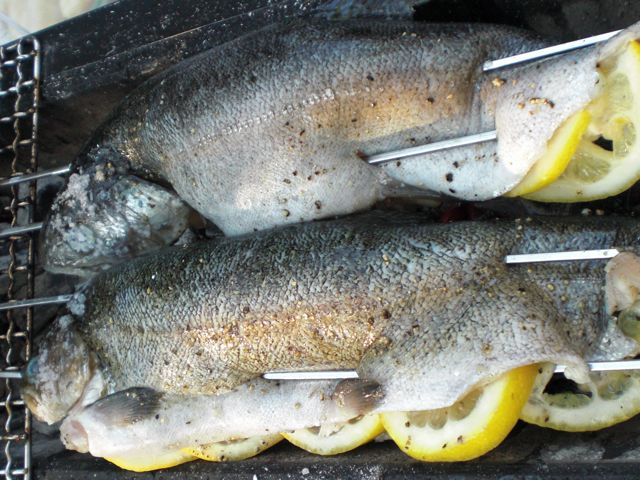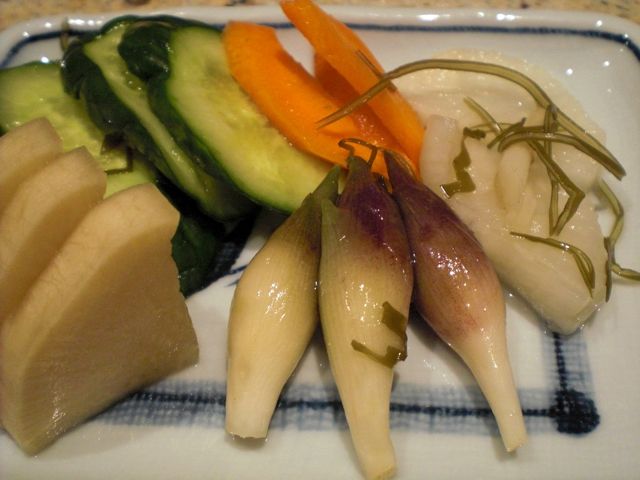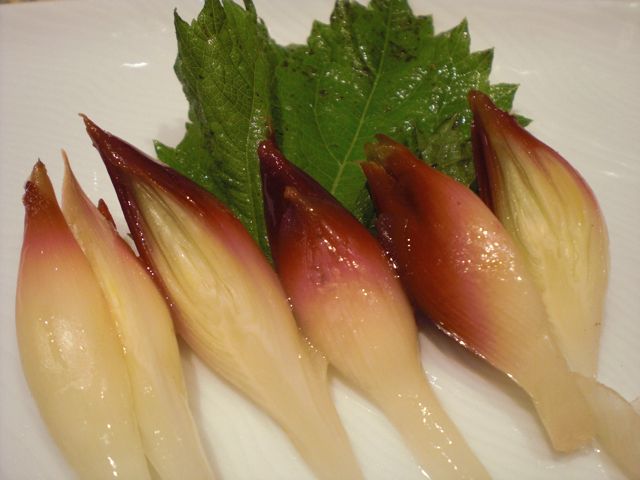I fondly remember the large juicy grilled herring I ate at the Robatayaki/Izakaya specializing in grilled fish, which was next door to the my old favorite "Oden" place, Kastuya, before it moved from the quaint dead-end alley way near Oodouri park 大通公園 in Sapporo 札幌.
Thursday, August 5, 2010
Grilled Trout 鱒の塩焼き
The types of fish, especially whole fish, we can get in a regular market, is very limited. Among the whole fish we can get almost all the time is a trout. I thought I bought trout that was just cleaned but it turned out this one was deboned and butterflied as well. Since we were planning to grill outside, I decided to grill this fish as planned. I sprinkled it with salt and pepper all around and put sprigs of fresh thyme and slices of lemon inside the fish.

Since I do not like the skin to stick to the grill, I used two large metal skewers so that I can suspend the fish over the charcoals. The fish were fairly large but they just fit side-by-side.
 Grilled whole fish, in general, is difficult to present in a pleasing way. While trout, as a white fresh water fish can be rather bland, and if not fresh, inedible, this fish had a nice thyme flavor and the barbecue imparts a lovely smokiness. When we were in California, we used to cook trout all the time, because it was almost the only whole fish we could get, but we have not have had trout for a long time.
Grilled whole fish, in general, is difficult to present in a pleasing way. While trout, as a white fresh water fish can be rather bland, and if not fresh, inedible, this fish had a nice thyme flavor and the barbecue imparts a lovely smokiness. When we were in California, we used to cook trout all the time, because it was almost the only whole fish we could get, but we have not have had trout for a long time.
I fondly remember the large juicy grilled herring I ate at the Robatayaki/Izakaya specializing in grilled fish, which was next door to the my old favorite "Oden" place, Kastuya, before it moved from the quaint dead-end alley way near Oodouri park 大通公園 in Sapporo 札幌.
I fondly remember the large juicy grilled herring I ate at the Robatayaki/Izakaya specializing in grilled fish, which was next door to the my old favorite "Oden" place, Kastuya, before it moved from the quaint dead-end alley way near Oodouri park 大通公園 in Sapporo 札幌.
Monday, August 2, 2010
Myouga pickled in sweet vinegar 冥加の甘酢漬 Myouga asazuke 冥加の浅漬
This is probably the last installment of my "myouga" series. This year's crop was not as good as other years but we had enough myouga to enjoy.

I think I am running out of myouga recipes. You could of course use finely chopped myouga as a condiment for anything including cold tofu 冷や奴, miso or clear soup, chawanmushi 茶碗蒸し, noodle dishes, sunomono 酢の物 dishes etc.
The picture below is myouga in sweet vinegar. This is a rather common preparation of myouga and I was told you could get this as a commercial product (in Japan). The recipe is rather simple. I first make sweet vinegar by dissolving sugar in Japanese rice vinegar (I used about 100m of vinegar with 4 tbs of sugar but the proportion is to your taste. I thought this was a bit too sweet but my wife thought it was just fine). I just microwaved it for 30-40 seconds or until the vinegar is warm enough to dissolve the sugar completely. Do not boil, it will make the vinegar less potent. (On the other hand, you may want to gently boil it in a pan to make the sweet vinegar more mellow). I then blanched the cleaned myouga, drained and added it to the sweet vinegar while the myouga are still hot. I keep this in a refrigerator for at least 3 days before eating. The one shown here is about a week old and still nicely crunchy with a sweet vinegar flavor mixed with the distinctive myouga taste. I do not know how long this will keep but I am sure, at least, several weeks. This is perfect for sipping sake or with rice.
 This is an assortment of asazuke 浅漬け (cucumber, carrot, daikon, in the back from left to right) and beer marinated daikon (front left) but the main item is, of course, myouga. I made the other vegetables exactly the same way as I posted before but I did not add ginger or hot pepper flakes. In addition to the nice myouga buds, I also added the chopped up stalk of myouga as well. This one has a purely myouga flavor with nice crisp texture.
This is an assortment of asazuke 浅漬け (cucumber, carrot, daikon, in the back from left to right) and beer marinated daikon (front left) but the main item is, of course, myouga. I made the other vegetables exactly the same way as I posted before but I did not add ginger or hot pepper flakes. In addition to the nice myouga buds, I also added the chopped up stalk of myouga as well. This one has a purely myouga flavor with nice crisp texture.
Saturday, July 31, 2010
Sliced roasted pork wrapped potato salad ポテトサラダのローストポーク巻き
This is another nothing dish I quickly made from leftovers. You could make this with commercial ham as well.
I just put a small amount of the potato salad on the sliced pork and made it into a roll and cut it in half. I served it with a cornichon. This goes well with any drink; wine, beer or sake. We had this with sake. Smokey pork flavor really matched well with the creamy starchy potato salad. Although the presentation can be improved, this is such quick nothing dish yet very good and satisfying.
Thursday, July 29, 2010
Myouga, broccoli and cumber salad with sesame mayonnaise 茗荷、ブロッコリ、キュウリの胡麻醤油マヨネーズ和え
For two servings like the one in the picture, I blanched broccoli florets (about 8) and shocked them in ice cold water, so they are green and crunchy. I peeled and cut one medium tomato into 8 wedges (this was very ripe home grown-by my friend- tomato), and halved and thinly sliced myouga (4-5), and cut a cucumber in "Jabara" 蛇腹 (1 American mini-cucumber)which was further cut into a bite size (a bit larger than half inch chunks) and lightly salted.
Dressing: I dry roasted white sesame seeds (2 tbs) in a frying pan for 2-3 minutes until they slightly browned and fragrant. I tipped them into a Japanese mortar or suribachi and ground them coarsely (some oil will come out). I added sesame paste (1 tsp) and soy sauce (2tsp) and mayonnaise (2 tbs, happened to be home made) and mixed. Taste and adjust the amount of soy sauce if needed.
I just arranged the vegetables, poured the dressing and topped it with white sesame seeds.
This is a hybrid Japanese/Western salad but the combination worked well.
Tuesday, July 27, 2010
Myouga, chicken and duck tenderloin tempura 茗荷、鶏と鴨の笹身の天ぷら
We do not particulary like to make tempura of myouga because the myouga seems to lose its flavor when cooked, but this one came out ok. Again, the myouga was used as a part of the tempura assortment rather than the main item.

The chicken tenderloin was stuffed with minced pickled plum or "umeboshi" 梅干し which is called "bainiku" 梅肉, then wrapped in perilla leaves. This is exactly the way I usually make this dish (Left in the back in the above picture). Since I separated the tenderloin from the duck breast when I made a duck breast dish, I wrapped it with a small rectangular sheet of nori 海苔. Whenever nori or aonori is used in this fashion or mixed into the tempura batter, it is called "Isobe age" 磯辺揚げ meaning "Rocky seashore fries" (Right in the back ). The tempura batter is my usual; a mixture of ice cold water and cake flour (I did not add potato starch this time because I was a bit lazy). I also fried this using the shallow frying method rather than deep frying.
I fried the myouga last, briefly and at a higher temperature than other items, which helped retain the flavor. When you cook myouga (such as in a miso or clear soup) the unique flavor of myouga diminishes quickly. I served this with an wedge of lemon and green tea salt.
I fried the myouga last, briefly and at a higher temperature than other items, which helped retain the flavor. When you cook myouga (such as in a miso or clear soup) the unique flavor of myouga diminishes quickly. I served this with an wedge of lemon and green tea salt.
Sunday, July 25, 2010
Miso pickled Myouga みょうがの味噌漬け
In any case, I just smear enough red miso to coat all freshly harvested, washed and dried myouga. I put them in a Ziploc bag for over 10 days in a refrigerator and it is ready to eat. This is about 2 weeks old. Just wash off the miso and cut in half and serve. This is a perfect accompaniment for sipping sake. The myouga is still tastes fresh and is crunchy yet has an added nutty salty miso flavor.
We have been harvesting myouga every weekend for the past few weeks. This year's crop is not as plump, big, or numerous as other years. The flavor, however, is very strong. Nonetheless even though small, some started flowering (far left). As I said before, once it flowers, the bud became loose and soft and does not taste good.
Saturday, July 24, 2010
Home grown tomatoes 家庭菜園トマト
Subscribe to:
Posts (Atom)

